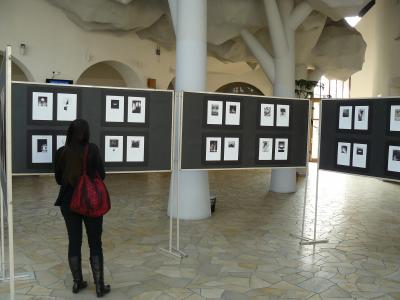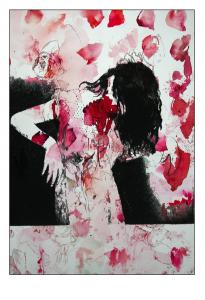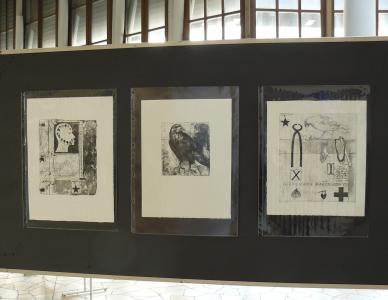From Text to Image
For past centuries, the study of translating poetry and the translatability of poetry have produced so many academic volumes that could fill a library, and also many concerns have been raised whether it is possible at all to translate poetic texts from one language to another; whether they would win or lose if they are translated. Also, when they are being translated, what should translators seek to do; should they confine to rephrasing the content of the source text or the “atmosphere” of the poetic images, or focus on the “formal characteristics”? This dilemma has been present for long and perhaps these questions will never be given a satisfactory answer.
Alan Turnbull lectures in Fine Art at Newcastle University's School of Arts and Cultures. His artwork can be found in several international public collections including Harvard University's Permanent Collection, The Vladimir Nabokov Museum in St. Petersburg, and Dresden City Council. An exhibition of his most recent work (digital prints and etchings) can be seen at the Faculty of Humanities and Social Sciences at Pázmány Péter Catholic University. The exhibition is presented in the foyer of Stephaneum, the central building on campus. The artist’s works have received numerous awards from the Arts Council of England, which signals that the pictures on display merit a close and detailed look. The exhibition area is open to any passers-by who can walk around it as many times a day as they wish. The Translated Images may also be seen as illustrations to poems; but the pictures arranged on four screens with grey background, as if they were windows, offer a new view on the poetry of János Pilinszky and Ted Hughes.

Regardless what advanced command of the target language translators may have, certain texts resist being translated from one language to another. It is particularly true in the case of such poetic texts whose complex images, tropes, and motives that may recur in other texts and even volumes puzzle native speakers and readers of the source language to such an extent that they can more or less interpret the enigmatic lines only after reading them several times. This complexity and semantic density also characterizes the poetry of János Pilinszky and Ted Hughes. Alan Turnbull’s etchings and digital prints offer a special interpretation of these two poets’ work, and show how the text of poetry translates into visual images. There exists a literary connection between certain parts of the two poets’ oeuvre as Ted Hughes, with the help of János Csokits’ rough translations, turned Pilinszky’s poems into English, and now the artist Alan Turnbull has created a further, visual connection with his pictures on display.


The first sequence, The Desert of Love, recalls Hughes’ Pilinszky translations, focusing particularly on the main motifs of his poetry that range from snow, stone, and earth to the isolated figure. An exceptionally strong imagery permeates the language of Pilinszky’s texts, and his poems, as Turnbull’s artwork shows, can be reduced to central still images that reveal the essence of the texts. As the artist confesses ‘In the concluding sentence of Hughes’ introduction to The Desert of Love he describes his translations as ‘pointers to help a reader re-imagine the whole thing’. These digital prints have something of a similar aim. My intention in making them was to find a visual equivalent to the style of writing Hughes admired in Pilinszky: focused, concentrated and bare.’

The second sequence comprises etchings inspired by Ted Hughes’ volume Crow: From the Life and Songs of the Crow. Similarly to the Pilinszky sequence, Turnbull spotlights the dark, primitive and sometimes ugly verbal world of the poems; the scratched out, direct and distracted lines are meant to illustrate the voice of the poems and the utterances of language.
In his introduction to the exhibition, Turnbull explains, ‘Any translation from the written word into visual form allows an artist considerable freedom of interpretation. The imagery here, though continually circling around the writings of Pilinszky and Hughes, is drawn from a wide range of sources and personal experiences. ‘The purpose of poetry is to make one moment of existence unforgettable’. So says the narrator in Milan Kundera’s novel Immortality. Both Pilinszky and Hughes managed to fulfil such a purpose by making poems that leave an indelible mark on our consciousness and which provide a powerful resource for further creative engagement.’
The language of visual representation transforms inaccessible and indescribable ideas into comprehensible and imaginable ones. It can allow complex signs, which point beyond our linguistic capacity, to become decodable and translatable; thus it opens the linguistically limited terrain and gives ground to another system of signs. And this unique code-switching results in the birth of new works of art.
Alan Turnbull, The Translated Image: Modern Poetry in Visual Language
Pázmány Péter Catholic University
Open from 21 March to 10 April 2013
(Photos by Alan Turnbull and Imre Dobri)



Facebook-hozzászólások